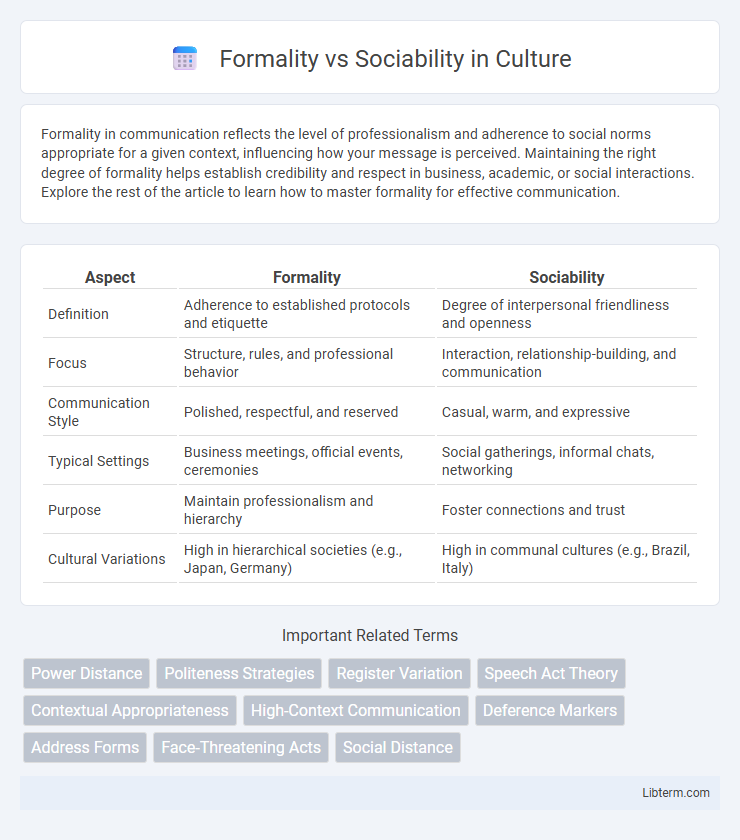Formality in communication reflects the level of professionalism and adherence to social norms appropriate for a given context, influencing how your message is perceived. Maintaining the right degree of formality helps establish credibility and respect in business, academic, or social interactions. Explore the rest of the article to learn how to master formality for effective communication.
Table of Comparison
| Aspect | Formality | Sociability |
|---|---|---|
| Definition | Adherence to established protocols and etiquette | Degree of interpersonal friendliness and openness |
| Focus | Structure, rules, and professional behavior | Interaction, relationship-building, and communication |
| Communication Style | Polished, respectful, and reserved | Casual, warm, and expressive |
| Typical Settings | Business meetings, official events, ceremonies | Social gatherings, informal chats, networking |
| Purpose | Maintain professionalism and hierarchy | Foster connections and trust |
| Cultural Variations | High in hierarchical societies (e.g., Japan, Germany) | High in communal cultures (e.g., Brazil, Italy) |
Understanding Formality and Sociability
Formality refers to adherence to established rules, protocols, and structured communication often found in professional or official settings, emphasizing clarity, respect, and hierarchy. Sociability involves informal interactions characterized by friendliness, openness, and the building of personal relationships, which foster trust and collaboration. Understanding the balance between formality and sociability enhances effective communication by aligning tone, language, and behavior with context and audience expectations.
Key Differences Between Formality and Sociability
Formality emphasizes adherence to established rules, protocols, and structured behavior, often observed in professional or official settings. Sociability highlights interpersonal warmth, friendliness, and informal interactions aimed at building relationships and social bonding. The key difference lies in formality prioritizing order and decorum, while sociability prioritizes emotional connection and openness.
The Role of Formality in Communication
Formality in communication establishes clear expectations, professional boundaries, and respect, which enhances clarity and reduces misunderstandings in both workplace and official settings. It supports structured interactions by emphasizing standardized language, titles, and protocols that signal authority and credibility. This rigid framework contrasts sociability's informal approach, ensuring efficiency and seriousness in task-oriented exchanges.
Sociability: Benefits in Social Interactions
Sociability enhances social interactions by fostering open communication and building strong interpersonal connections, which lead to increased trust and collaboration. High sociability promotes empathy and active listening, creating a positive environment that encourages mutual understanding and conflict resolution. This dynamic facilitates network expansion and support systems essential for personal and professional growth.
Contexts Where Formality is Essential
Formality is essential in professional and legal contexts where clear hierarchy and protocol ensure effective communication and decision-making. In corporate meetings, formal language reinforces respect and authority, preventing misunderstandings in high-stakes negotiations. Legal documents and diplomatic interactions rely on precise, formal expressions to uphold accountability and maintain official standards.
Settings That Favor Sociability
Settings that favor sociability often include informal environments such as cafes, social clubs, and casual workplaces where relaxed interactions and open communication thrive. These settings encourage relationship-building, collaboration, and spontaneous conversations by minimizing hierarchical structures and formal protocols. The presence of shared interests and comfortable atmospheres enhances social bonding and network growth in such sociable spaces.
Balancing Formality and Sociability in the Workplace
Balancing formality and sociability in the workplace enhances communication efficiency and fosters a positive company culture. Maintaining professional etiquette while encouraging friendly interactions promotes trust and collaboration among employees. Organizations that successfully integrate structured protocols with approachable social dynamics experience increased productivity and employee satisfaction.
Cultural Influences on Formality and Sociability
Cultural influences significantly shape formality and sociability, affecting communication styles and social interactions across societies. In high-context cultures like Japan, formality governs social exchanges, emphasizing respect and hierarchical relationships, while low-context cultures such as the United States prioritize directness and sociability in communication. Understanding these cultural nuances enhances cross-cultural competence, facilitating effective interpersonal and business interactions globally.
Impact on Relationships and Networking
Formality in communication establishes clear boundaries and professionalism, enhancing trust and respect in business relationships while potentially limiting emotional connection. Sociability fosters warmth and rapport, encouraging openness and collaboration through informal interactions that strengthen personal bonds. Balancing formality and sociability optimizes networking by combining credibility with approachability, creating durable and effective professional relationships.
Tips for Navigating Formal and Social Environments
Master clear communication by adjusting your tone to match the setting, using polite language and professional gestures in formal environments while embracing warmth and openness in social situations. Observe social cues carefully; formal settings often demand restraint and structure, whereas sociable spaces invite relaxed body language and conversational engagement. Prepare conversation topics suited to the context, favoring industry-related subjects for formal events and shared interests or hobbies to foster connections in social gatherings.
Formality Infographic

 libterm.com
libterm.com